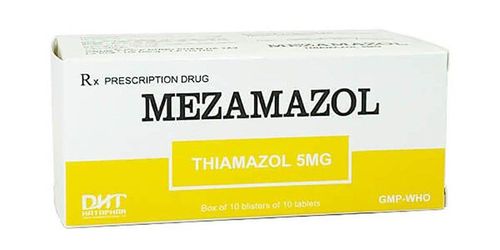This is an automatically translated article.
What is Propylthiouracil 50mg? What is Propylthiouracil 50mg used for? What is the correct way to drink? What points need to be paid attention to when using? The following article will help you better understand the uses of Propylthiouracil 50mg and the notes when using Propylthiouracil 50mg.
1. What are the uses of Propylthiouracil 50mg?
1.1. What is Propylthiouracil 50mg? Propylthiouracil 50mg is a hormone medicine, hormonal drug. Have drug Visa number / Registration number / phone number: V526-H12-05. This is a product manufactured by Vinh Phuc Pharmaceutical Joint Stock Company (VINPHACO). Propylthiouracil 50mg contains Propylthiouracil, which is packaged in film-coated tablets.
1.2. What is Propylthiouracil 50mg used for? Propylthiouracil 50mg for the treatment of hyperthyroidism. Reduction of pre-existing hyperthyroidism during total thyroid surgery or radioactive iodine therapy.
Comply with the correct use of the drug according to the indications (uses, functions for whom) stated on the instruction sheet for Propylthiouracil 50mg or the doctor's prescription sheet.
You can take this medicine propylthiouracil to treat an overactive thyroid (hyperthyroidism). It works by stopping the thyroid gland from producing too much thyroid hormone.
Propylthiouracil is not recommended for use in children.
2. Usage of Propylthiouracil 50mg
2.1. How to take Propylthiouracil 50mg Patients should carefully read the instructions for use before starting propylthiouracil and each time they use the drug again
Patients should take this medication by mouth with food or as directed by a doctor, usually is 3 times a day (every 8 hours).
This dosage is based on the patient's medical condition and response to treatment.
Should take the medicine exactly as directed. Do not increase your dose or take it more often than prescribed. The patient's condition will not improve any faster and there is even an increased risk of side effects.
Take this medicine regularly to get certain benefits from it. To help the patient remember, it should be taken at the same time every day. Do not stop taking this medicine without consulting your doctor.
2.2. Dosage of Propylthiouracil 50mg Adults: The daily dose is usually divided into 3 small doses, taken about 8 hours apart.
During treatment, it is necessary to rely on T3, T4 and TSH indexes to adjust the dose to bring these indexes within normal limits. Because determining only one T3 index will not accurately reflect the treatment requirements, while determining only the TSH concentration will easily increase the necessary level of the therapeutic dose level of antithyroid drugs.
The initial dose is 300 mg/day and divided into 3 divided doses, 400mg/day for patients with severe hyperthyroidism or very large goiter, a dose of 600-900mg/day can be used for patients with a stroke. variable. Maintenance dose: 50 - 150 mg per day, as a single daily dose or in 3 divided doses if needed. A dose of 800 - 1 200 mg per day is equivalent to a dose of 200 - 300 mg per time, administered every 4-6 hours. After that can be reduced and maintenance dose from 100 to 600 mg per day, divided into several doses. Initial dose 300 mg per day, divided into 3 times. For patients with severe severe hyperthyroidism and/or very large goiter, the starting dose may be increased to 400 mg/day, and a dose of 600-900 mg/day may be used. Some recommend stopping Propylthiouracil 2-7 days before taking radioactive iodine; Propylthiouracil can be restarted 3-7 days after radioactive iodine treatment, then stopped Propylthiouracil when normal thyroid function returns. Dosage 300mg/time per day. Use for 8-12 weeks. Treatment with Propylthiouracil: The starting dose is usually 1-3 months, then gradually reduce the dose to avoid hypothyroidism.
Stop treatment after about 12 - 18 months. Monitor thyroid function after every 2 months of treatment, when the disease is in remission, it can be checked every 6 months, followed by annual follow-up.
Reference range of indices: Total T4: 5 - 12 mcg/dL. Serum T3: 90 - 185 nanograms/dL. Free thyroxine index (FT4I): 6 - 10.5. TSH: 0.5 - 4.0 micro units/ml.
Children: The starting dose is 5-7 mg/kg/day or 150-200 mg/m2/day in divided doses, taken 8 hours apart. Or by age:
Newborns: 2.5 - 5 mg/kg, 2 times/day. Children 1 - 5 years old: 25 mg/time, 3 times/day. Children 5 - 12 years old: 50mg/time, 3 times/day. Children 12-18 years old: 100mg/time, 3 times/day. Maintenance dose for children: 1/3 to 2/3 of the initial dose, divided into small doses taken 8-12 hours apart.
Other subjects: Patients with renal failure:
Clcr: 10 - 50 ml/min: Use 75% of the usual dose. Clcr < 10 ml/min: Use 50% of the usual dose. Patients with hepatic impairment: Reduce dose as directed by your doctor.
2.3. Overdosage of Propylthiouracil and Management Overdosage and toxicity: Overdosage of Propylthiouracil may cause an increase in the ADR commonly seen as: Nausea, vomiting, epigastric pain, headache, fever, arthralgia, pruritus, edema and decreased total blood count. bridge. Agranulocytosis is the most serious ADR caused by Propylthiouracil overdose. Exfoliative dermatitis and hepatitis also occur.
How to deal with overdose: When taking an overdose of Propylthiouracil, it is necessary to treat symptomatically and supportively. In acute overdose, induce vomiting or gastric lavage. If the patient is comatose, has seizures, or has lost the vomiting reflex, gastric lavage and intubation with an inflated balloon can be performed to prevent aspiration of vomit.
Initiate appropriate therapy, which may include anti-infectives and whole fresh blood transfusion if myelosuppression is present. If you have hepatitis: You need to have a proper diet and rest. Analgesics, sedatives, and intravenous fluids can also be used to treat Propylthiouracil overdose.
Missed dose and treatment: If you forget to take a dose, take it as soon as you remember. However, if it is almost time for your next dose, skip the missed dose and take your next dose at the scheduled time. Do not take twice the prescribed dose.
3. Notes when taking Propylthiouracil 50mg
3.1. Propylthiouracil is contraindicated in the following cases: History of severe blood diseases (agranulocytosis, aplastic anemia...). History of hepatitis. History of vasculitis. History of nephritis. Allergy to Propylthiouracil or to any of the ingredients. Do not use Propylthiouracil with other drugs containing: Clozapine, sodium iodide 131I.
Propylthiouracil may increase the effects and toxicity of glycosides, clozapine, theophylline derivatives.
Propylthiouracil may reduce the effect of: Sodium iodide 131I and vitamin K-like anticoagulants
Taking with food may alter plasma concentrations of the drug.
Concomitant use with drugs that cause agranulocytosis may further increase the risk of agranulocytosis.
Hyperthyroidism causes increased elimination of beta-blockers. Therefore, it is necessary to reduce the dose of this class of drugs when the patient's hyperthyroidism is reduced.
3.2. Caution for pregnant women Propylthiouracil crosses the placenta, may cause fetal toxicity (goiter and hypothyroidism in the fetus). If the drug must be used, the dose should be adjusted carefully, enough but not too high. Propylthiouracil is recommended for use in early pregnancy and to reduce the risk of hepatotoxicity, it should be used as an alternative to methimazole for mid and late pregnancy.
3.3. Note to nursing women Propylthiouracil is distributed into breast milk in very small amounts, so it does not cause serious reactions in the baby.
3.4. Precautions while driving and using machines There are no data to determine whether Propylthiouracil affects the ability to drive and use machines.
3.5. Some other notes when taking Propylthiouracil 50mg for: Patients should immediately report any signs of illness, sore throat, skin rash, fever, headache or general discomfort so that a white blood cell count can be performed. and other blood counts. There have been reports of insulin autoimmune syndrome during the use of the drug. There have been reports of hepatic dysfunction in neonates when this drug is used during pregnancy or lactation. Use with caution in the following patients: Patients with liver disorders. Patients with severe or moderate leukopenia, or hematopoietic disorders. The drug can cause goiter and hypothyroidism in the fetus. The safety of this drug in pregnant women has not been established. If this drug is used during pregnancy for the treatment of hyperthyroidism, the dose should be adjusted cautiously based on the results of periodic thyroid function tests. The drug is secreted into breast milk (1/10 of the blood concentration). Therefore, you should not breast-feed while taking this medicine.
4. Side effects of Propylthiouracil 50mg
Patients need to go to the hospital immediately if the body has any signs of an allergic reaction: hives, difficulty breathing, swelling of the face, lips, tongue or throat.
Serious side effects may include: Fever, sore throat, headache, body aches, flu symptoms; pale skin, easy bruising or bleeding (nosebleeds, bleeding gums), weakness in the body; Dry cough, difficulty breathing; Severe blistering, peeling, red skin rash.
Propylthiouracil can also cause severe liver symptoms. Call your doctor right away if you have any of these liver symptoms: Low-grade fever, itching; Nausea, abdominal pain, loss of appetite; Dark urine, clay-colored stools; Jaundice (or eyes).
Common side effects may include: Abdominal pain, vomiting; Dizziness, spinning sensation; mild skin rash or itching; Mild joint or muscle pain; Decreased taste; Hair loss.
Not everyone experiences these side effects. There may be other side effects not mentioned. If you have any questions about side effects, consult your doctor or pharmacist.
5. How to store Propylthiouracil 50mg
The medicine should be stored at room temperature, away from moisture and light.
Do not store in the bathroom or in the freezer. It should be remembered that each drug may have different storage methods. Therefore, patients should carefully read the storage instructions on the packaging, or ask the pharmacist. Keep medicine out of reach of children and pets.
Please dispose of medicine properly when it is expired or cannot be used. You can consult your pharmacist or local waste disposal company about how to safely dispose of your medication.
Please dial HOTLINE for more information or register for an appointment HERE. Download MyVinmec app to make appointments faster and to manage your bookings easily.













